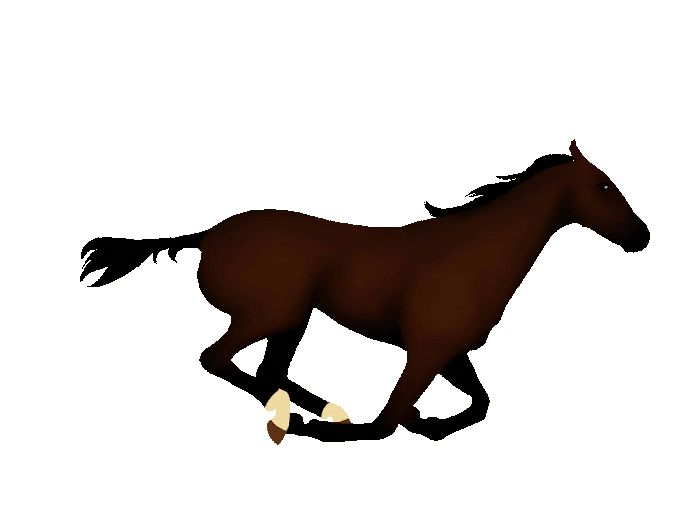RACING AND THOROUGHBRED
Nearly all of today’s racehorses can be traced back to one of three ‘foundation’ stallions – The Darley Arabian, The Godolphin Arabian and The Byerley Turk.
They were Arabian horses, imported into England between the late 17th and early 18th century by gentlemen who wanted to breed better racehorses. When they bred with Britain’s native, heavier horses, they produced offspring who were much faster, but still had great stamina – they were the very first ‘thoroughbred’ racehorses.
As with humans, some horses are just naturally better suited to running; some are built to be sprinters, with bulging muscles and a rapid stride, others are long distance athletes, lean and supple with an long stride – not unlike the differences you would see between human sprinters and marathon runners.
Flat racehorses can start their racing career at just two years old – and some of them retire by the age of four, although many can go on racing much longer, until they are ten or older. Although some of the most prestigious races are confined to three year olds, generally flat racehorses tend to be at their peak aged four or five.
Racehorses are allowed to race from the age of two years old. Often these are called Juvenile races.
All horses born in the same year share their official birthday as the 1st January. When racing as two-year-olds, a horse born in the early months of the year is likely to be more mature than one born later, despite officially being the same age.
A racehorse weighs around 500kg
The average heart of a racehorse weighs the same as four bags of sugar
A racehorse drinks up to 10 gallons of water a day
Colours
There are seven different official colours for racehorses. You can see the abbreviations for each colour below in the racecard on raceday next to each horse.
Grey (Gr) – ranging from bright white to steel-coloured grey.
Bay (B) – covers a huge range of the colour brown, from bright bay through to dark bay, which is basically black. Bay horses have black manes and tails.
Chestnut (CH) – a reddish or ginger coat colour, with a mane and tail to match.
Roan (Ro) – a Roan horse has an even mixture of white hairs mixed in with another colour.
Brown (Br) – a horse registered as Brown will also have a brown mane and tail.
Black (Bl) – a purely black horse, but this is rare!
White (Wh) – this classification is also very rare. Most horses that appear to be white will in fact be classed as Grey, with black skin. Grey horses tend to get lighter in colour as they get older.
The Thoroughbred is the most common breed of horse used in racing and the ones you’ll typically see at racecourses across the country.
They are incredible athletes and a spectacle to witness at full gallop. Horseracing is a sport of beauty and power, but it is also one of many potentially confusing terms and phrases if you’re not familiar with the language.
Ages of horses.
Colt – a young male horse up to the age of four
Filly – a young female horse up to the age of four
Mare – a female horse aged five or older
Horse – a colt is referred to as a ‘horse’ after the age of five
Sire – the father of a horse
Dam – the mother of a horse
Stallion – a male horse used for breeding
Broodmare – a female horse used for breeding
Broodmare dam – a female horse whose offspring are also broodmares
Broodmare sire – a male horse whose daughters have become successful broodmares
Foal – newborn horse up to one year old
Yearling – a one-year old horse
Gelding – a male horse castrated usually to make it more even-tempered
Maiden – a horse that has yet to win a race
Common Phrases in horse racing.
Progressive – a horse whose performance and ability is improving Backward – a horse that is physically immature for its age.
Sprinter – a horse that is best over shorter distances
Miler – a horse that prefers races over the distance of a mile
Stayer – a horse that prefers to race over distances of a mile and six furlongs or longer
Off the bit/Off the bridle – a description used for a horse being encouraged along by his jockey
On the bit/On the bridle – a horse that is going well and still full of running, with a firm hold on the bit
Banker – a horse considered very likely to win (bankers are often the cornerstone of complex multiple bets)
Racehorses can run 100m in half the time it takes the fastest humans on the planet to do so at top speed, which puts them among the fastest animals.
Racehorse speed is a product of both nature and nurture or, in other words, a combination of biology and diet.
Biologically speaking, horses of all kinds are strong runners because, in many ways, they are built for speed. The lower part of a horse’s leg is comprised of tendons and ligaments around the bone, rather than the muscles you would find in humans and other mammals. These tendons and ligaments help horses run at a quicker, steadier pace.
When it comes to diet, owners must not only consider the broad nutritional requirements of their racehorse, but also how to best provide them with enough fast-release energy to allow him or her to race at the top of the sport. A horse must be fed the correct diet of high-quality proteins, fibre, starch and fat in order to have enough fuel to race at such speeds.
Although racehorses are natural athletes famed for their speed and stamina, they must be well looked after before, during and after races in order to achieve their full potential.
Without carefully managed water intake and a specific diet containing the requisite fuel for strategic energy release, a racehorse will not be able to remain at the top of his or her game.
How much water does a racehorse need?
The average body of a mature horse is 65 per cent water, which translates to a whopping 85 gallons. In order to maintain hydration, an inactive horse in a cool environment must take in between seven and 10 gallons of water every day, while in a warmer environment like on racedays, a horse may need to drink up to 20 gallons per day to stay adequately hydrated.
However, when a horse exercises and sweats, it loses fluid. During a race, a horse can lose up to eight gallons of water – representing more than 10 per cent of its water reserves.
Like humans, horses cool themselves through the process of sweating. The protein latherin allows a horse’s sweat to escape through its coat, helping it to lower the overall body temperature to stay comfortable.
What kind of diet does a racehorse need?
In order to keep a racehorse performing at its best and looking fit and healthy, it must be fed the right combination of foods. The foundation of a racehorse’s diet should be high-quality forage – it holds water and electrolytes well and is highly nutritional.
The horse’s feed must also contain soluble carbohydrates that will provide him or her with the energy that is needed for glycogen replacement. Glycogen is used by racehorses to reach high speeds while training and exercising, so a diet high in grains and other glycogen-rich foods means the horse will avoid premature fatigue in the middle of a race.
In order to maximise the performance of a racehorse, it is important to decrease training intensity in the three-to-four days leading up to an important race. This will ensure that the horse’s stores of glycogen are not compromised or diminished and that it has all the energy it needs to perform at its best.
The diet of a racehorse has to be thoroughly planned, carefully managed and strictly adhered to if they are to compete at the highest level.
Racehorses require a diet that is high in energy to fuel the levels of performance needed in today’s sport. They must always be well-hydrated, too, even during daily training routines.
Diet of the Race Horse
Like a human athlete, the nutritional requirements of a racehorse are centred on giving them the energy to compete. Without a supply of fast- and slow-release energy, a racehorse may not be able to perform at its best, so it all begins with high-energy foods.
When racehorses train and exercise, their muscles use small adenosine triphosphate (ATP) molecules to encourage muscle contraction. One element of a racehorse’s diet focuses on optimising its stores of ATP so that its muscles can keep contracting without getting tired.
The best and most important fuels for a racehorse are fat and glycogen, particularly because muscle glycogen is the main fuel used during a race. Therefore, diets high in fat, protein, fibre and starch are appropriate for high-performance racehorses and they can obtain most of these nutritional elements from a combination of forage (grass and hay) and grains, such as oats, corn and barley.
Diet of a jockey
Just like their equine counterparts, jockeys also have to stick to strict diets and training regimes. They must remain at a fit and healthy weight so they often avoid overly fatty foods and carbohydrates, whilst steering clear of calorie-rich things like alcohol.
They do, however, require frequent sugar boosts to maintain their glucose levels. This is often achieved through eating jelly-based sweets during breaks in training and drinking tea with sugar at mealtimes.




0 Comments